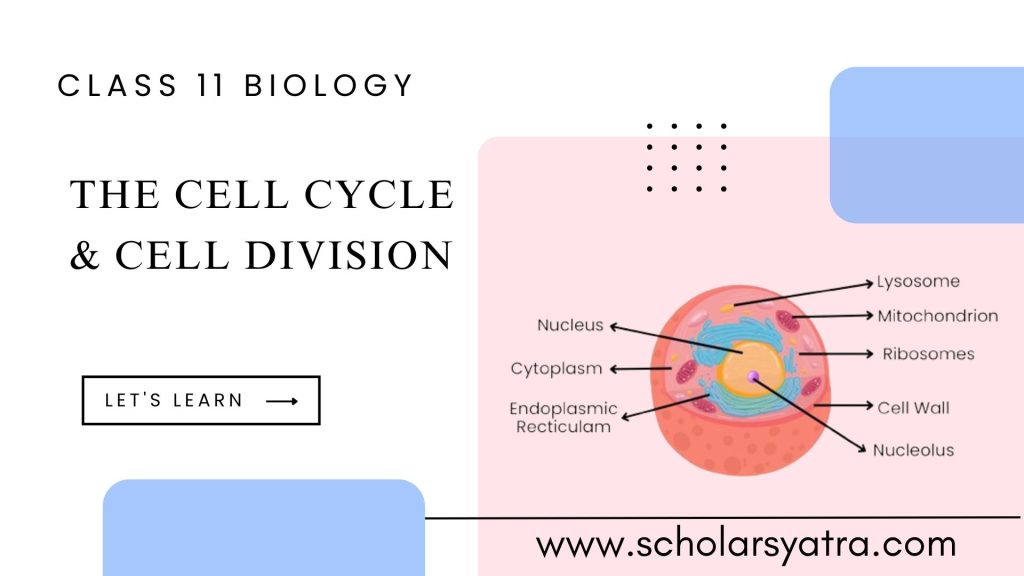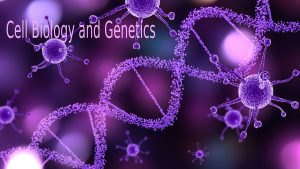Explore the cell cycle and cell division, which are two related topics, providing a deep concept of the cell cycle and cell division for biology scholars. Cell Cycle and cell division notes discuss the processes of cell cycle regulation and cell division, fundamental to the growth, development, and reproduction of organisms. The chapter highlights the distinct phases of cell division—interphase and mitotic phase— and their significance.
Table of Contents
ToggleThe Cell Cycle and Cell Division
Cell Division: All the living cells have a unit property of multiplication action, such property of action of multiplication is called Cell division.
Comparison of Cell Division Types
| Characteristic | Amitosis | Mitosis | Meiosis |
|---|---|---|---|
| Occurrence | Simple organisms | Somatic cells | Germ cells |
| Number of Daughter Cells | 2 | 2 | 4 |
| Genetic Similarity | Often unequal | Identical | Non-identical |
| Function | Asexual reproduction | Growth and repair | Sexual reproduction |
Cell Cycle: The cell cycle refers to the series of events that cells go through as they grow and divide. It is crucial for growth, repair, and reproduction in living organisms. When a cell divides, it also copies its DNA and grows bigger. All these activities of cell division, DNA copying, and growth—need to happen together in the right order to make sure cells split correctly and make new cells with complete sets of genes. The complete process of a cell copying with its DNA, making more cells, and splitting into two new cells is called the “cell cycle.” The cell cycle is divided into two main phases:
- Interphase: This is the longest phase of the cell cycle, where the cell grows, replicates its DNA, and prepares for cell division. It’s like the “preparation phase” before the actual division happens. Interphase consists of three sub-phases: G1 phase (Gap 1), S phase (Synthesis), and G2 phase (Gap 2).
- G1 phase (First Gap): Cell growth and synthesis of proteins.
- S phase (Synthesis): DNA replication occurs, ensuring that each new cell receives an identical set of chromosomes.
- G2 phase (Second Gap): Further growth and preparation for mitosis.
- M phase (Mitotic Phase): The M phase, or mitotic phase, is the phase of the cell cycle where actual cell division processes occur. This phase is also known as the phase of nucleus division. It consists of two main processes: Karyokinesis and cytokinesis.
The Karyokinesis stage of cell division involves further four stages, which are:
- Prophase,
- Metaphase,
- Anaphase, and
- Telophase.
1. Prophase:
- As prophase proceeds, the long strands of deoxyribonucleic acid and proteins, known as chromatin, shorten and thicken, resulting in well-defined chromosomes. A chromosome is composed of a pair of chromatid structures bonded together by a centromere in the center of the chromosome.
- The nucleolus gets smaller until it is no more, and the envelope of the nucleus becomes frayed at the edges.
- Centrioles (in the case of animal-type cells) travel to an opposite end of the main cell starting the assembly of the mitotic spindle – a structure that contains numerous microtubules that are vital for chromosome motion.
- Kinetochore fibers, which are specialized structures connecting the spindle to the chromosomes at the centromeres, seek attachment from the spindle apparatus.
Significance: Prophase is important in that it sets the stage for the alignment and separation of chromosomes within the cell. The role of chromatin condensation into chromosomes is also fundamental in the proper organization of the genetic material during cell division minimizing chances of getting entangled or broken up.
2. Metaphase
- In metaphase, genetic material is arranged in the middle of the cell at a zone known as the metaphase plate which separates the two chromosome poles.
- The spindle fibers are properly associated with the kinetochores of the chromosomes and this facilitates the connection of each sister chromatid to the opposite poles.
Significance: Metaphase is essential for the proper distribution of chromosomes to each daughter cell. The equatorial position of the chromosomes is focused on ensuring that the chromosomes will be correctly divided in the next step.
3. Anaphase
- Anaphase begins after the centromeres split, and the sister chromatids (now individual chromosomes) are pulled apart by the shortening of spindle fibers.
- The separated chromatids move to opposite poles of the cell.
Significance: Anaphase plays a crucial role in ensuring that each pole of the cell receives an identical set of chromosomes. and check the abnormal number of chromosomes.
4. Telophase
- All the daughter chromosomes get organized into the nucleus to their respective poles.
- All daughter cell has an equal number of chromosomes as their mother has.
Significance: Telophase is significant because it completes nuclear division and sets the stage for the physical separation of the cell’s cytoplasm (cytokinesis).
Cytokinesis: Cytokinesis is the process of cell division(cytoplasm) that occurs after the nuclear division phase (karyokinesis) in eukaryotic cells. It takes place by the cell furrow method in animal cells and the cell plate method in plants.
Differences Between Animal and Plant Cytokinesis
| Aspect | Animal Cells | Plant Cells |
|---|---|---|
| Mechanism | Cleavage furrow formation | Cell plate formation |
| Structural Proteins | Actin and myosin in the contractile ring | Vesicles and Golgi-derived materials |
| Resulting Structure | Two separate membranes | Cell plate becoming a new cell wall |
| Adaptation | Flexible membrane | Rigid cell wall |
What is Meiosis?
The process of fusion of two gametes (male and female) in Sexual reproduction, each containing a full haploid set of chromosomes. Gametes originate from specialized diploid cells. The unique type of cell division that halves the chromosome number, leading to the generation of haploid offspring cells, is termed meiosis. This Meiotic events are grouped into 2 phases: Meiosis I and Meiosis II each with distinct stages.
Phases of Meiosis I
The following are the phases of the Meiosis I:
- Prophase I:
- Chromosome Condensation: Chromosomes condense and become visible under a microscope.
- Synopsis and Crossing Over: Homologous chromosomes (chromosomes with the same genes but different alleles) pair up in a process called synapsis to form structures known as tetrads. During this process, genetic material is exchanged between homologous chromosomes in an event called crossing over, which increases genetic variation.
- Formation of Spindle Fibers: Spindle fibers form, and the nuclear envelope begins to disintegrate.
- Significance: Crossing over introduces genetic diversity by creating new combinations of alleles.
- Metaphase I:
- Alignment of Homologous Pairs: Tetrads align at the metaphase plate in a double-row arrangement.
- Attachment to Spindle Fibers: Spindle fibers attach to the kinetochores of each homologous chromosome.
- Significance: The random orientation of tetrads contributes to genetic variation through independent assortment.
- Anaphase I:
- Separation of Homologous Chromosomes: Spindle fibers pull the homologous chromosomes to opposite poles, separating the pairs but leaving sister chromatids intact.
- Significance: The reduction of chromosome number begins, ensuring that each daughter cell will be haploid.
- Telophase I and Cytokinesis:
- Reformation of Nuclear Membrane: A nuclear envelope may briefly reform around the chromosomes at each pole.
- Division of Cytoplasm: Cytokinesis occurs, forming two haploid cells, each containing half the number of chromosomes as the original cell.
- Significance: The two cells formed are haploid but still contain replicated sister chromatids.
Phases of Meiosis II
The following are the phases in Meiosis II:
Meiosis II resembles mitosis and serves to separate sister chromatids.
- Prophase II:
- Chromosome Condensation: Chromosomes condense again if they have de-condensed after Meiosis I.
- Spindle Formation: New spindle fibers form in each of the two haploid cells.
- Significance: Prepares the cells for the second division to separate sister chromatids.
- Metaphase II:
- Chromosome Alignment: Chromosomes line up individually along the metaphase plate, similar to mitosis.
- Attachment to Spindle Fibers: Spindle fibers attach to the kinetochores of each chromosome.
- Significance: Ensures that sister chromatids are properly aligned for equal separation.
- Anaphase II:
- Separation of Sister Chromatids: Centromeres split, and sister chromatids are pulled to opposite poles as separate chromosomes.
- Significance: The separation ensures that each daughter cell receives an equal number of chromosomes.
- Telophase II and Cytokinesis:
- Reformation of Nuclear Membranes: Nuclear membranes reform around each set of chromosomes.
- Chromosome De-condensation: Chromosomes de-condense, returning to their less compact state.
- Cytokinesis: The cytoplasm divides, resulting in four haploid daughter cells.
- Significance: The process results in four genetically unique haploid cells, each with half the original number of chromosomes.
Significance of Cytokinesis and Meiosis
- Genetic Diversity: The processes of crossing over in Prophase I and independent assortment in Metaphase I contribute to the genetic variation necessary for evolution and adaptation.
- Haploid Gamete Formation: Meiosis ensures that gametes have half the number of chromosomes, maintaining the species’ chromosome number after fertilization.
- Cellular Reproduction and Development: Proper cytokinesis ensures the distribution of cytoplasmic content, enabling daughter cells to function effectively after division.
Differences Between Mitosis and Meiosis
Mitosis and meiosis are both processes of cell division, but they serve different purposes and have key differences in their mechanisms and outcomes. Here is a detailed comparison between the two:
| Aspect | Mitosis | Meiosis |
|---|---|---|
| Purpose | Growth, repair, and asexual reproduction | Sexual reproduction and generation of gametes |
| Number of Divisions | One division cycle | Two division cycles (Meiosis I and Meiosis II) |
| Number of Daughter Cells | Produces 2 daughter cells | Produces 4 daughter cells |
| Chromosome Number | Daughter cells have the same number of chromosomes as the parent cell (diploid, 2n) | Daughter cells have half the number of chromosomes as the parent cell (haploid, n) |
| Genetic Composition | Genetically identical to the parent cell and each other | Genetically unique due to crossing over and independent assortment |
| Occurrence | In somatic (body) cells | In germ cells (cells that give rise to gametes) |
| Stages | Prophase, Metaphase, Anaphase, Telophase | Prophase I, Metaphase I, Anaphase I, Telophase I; Prophase II, Metaphase II, Anaphase II, Telophase II |
| Crossing Over | Does not occur | Occurs during Prophase I, leading to genetic recombination |
| Homologous Chromosome Pairing | Does not pair homologous chromosomes | Homologous chromosomes pair and form tetrads during Prophase I |
| Synopsis | Does not occur | Occurs in Prophase I during pairing of homologous chromosomes |
| Independent Assortment | Does not occur | Occurs during Metaphase I, contributing to genetic diversity |
| Function | Cellular growth, tissue repair, asexual reproduction | Formation of sperm and eggs for sexual reproduction |
| Duration | Typically shorter than meiosis | Generally longer due to the two stages of division |






